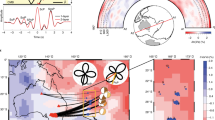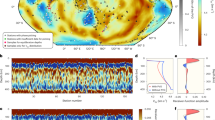Abstract
Saul and Vinnik's comment raises an interesting point concerning the influence of shear-coupled P-waves (such as SPmP) on shear-wave-splitting analysis. We used a method1,2 that applies a time window to the data, so P-wave energy on the horizontal components outside this window will have no effect on the analysis. As all but one of our events were recorded at stations located on thick (40–50 km) continental crust3, the Moho multiple arrivals to which we refer will generally be separated (>8 s for SPmP) from the main S-wave arrival. Error can occur when P-wave energy falls within the analysis window.
Similar content being viewed by others
Wookey et al. reply
We have re-analysed our data, applying a wavefield-decomposition technique4 before the shear-wave splitting analysis. The range of results changed from 0.6–7.1 s to 0.6–6.2 s, with ten results showing splitting greater than 1.5 s. This is more splitting than can be explained solely by VTI (transverse isotropy with a vertical axis of symmetry) in the upper mantle and still supports our conclusion of mid-mantle anisotropy.
The mistake that Saul and Vinnik have made is to assume a VTI medium and simply to look for splitting between the radial and transverse components. Although our results show a near-VTI symmetry on average (ϕAVE = 95.3°), there is plenty of scatter in the data. The lack of apparent splitting on the components of the seismogram (Fig. 1) is meaningless — the arrivals on the radial and transverse components are combinations of the off-axis fast and slow shear waves.
Our own analysis of this event using the wavefield-decomposed seismogram gives an even more convincing result than previously. We recover a lag time of 3.55 ± 0.2 s and a fast direction of 22 ± 2°. Rotated into the correct orientation, the traces show a clear split between similar shear waveforms; if the phase were truly not split (that is, no anisotropy), no such orientation would be possible.
This result shows more splitting than can be explained solely by VTI in the upper mantle. The a priori assumption of VTI media means that the methodology of Saul and Vinnik will be unable to detect any splitting with a fast direction that is neither horizontal nor vertical: even a small deviation will cause cross-contamination of the components.
Furthermore, their simple inspection of the waveforms is a qualitative method, relying on a subjective pick of the two phases, with no way of assessing errors. Our method produces a quantitative measurement of the error, allowing us to reduce our initial data set of 290 measurements to the 35 that are constrained sufficiently to draw robust inferences. We are left with a high-quality data set that we consider to be compelling evidence of mid-mantle anisotropy.
References
Wookey, J., Kendall, J.-M & Barruol, G. Nature 415, 777–780 (2002).
Silver, P. G. & Chan, W. W. Nature 335, 34–39 (2002).
Clitheroe, G., Gudmundsson, O. & Kennett, B. L. N. J. Geophys. Res. 105, 13697–13713 (1998).
Bostock, M. G. J. Geophys. Res. 103, 21183–21200 (1998).
Author information
Authors and Affiliations
Corresponding author
Rights and permissions
About this article
Cite this article
Wookey, J., Kendall, JM. & Barruol, G. Mantle deformation or processing artefact?. Nature 422, 136 (2003). https://doi.org/10.1038/422136b
Issue Date:
DOI: https://doi.org/10.1038/422136b
This article is cited by
-
Shear Wave Splitting and Mantle Anisotropy: Measurements, Interpretations, and New Directions
Surveys in Geophysics (2009)
Comments
By submitting a comment you agree to abide by our Terms and Community Guidelines. If you find something abusive or that does not comply with our terms or guidelines please flag it as inappropriate.



